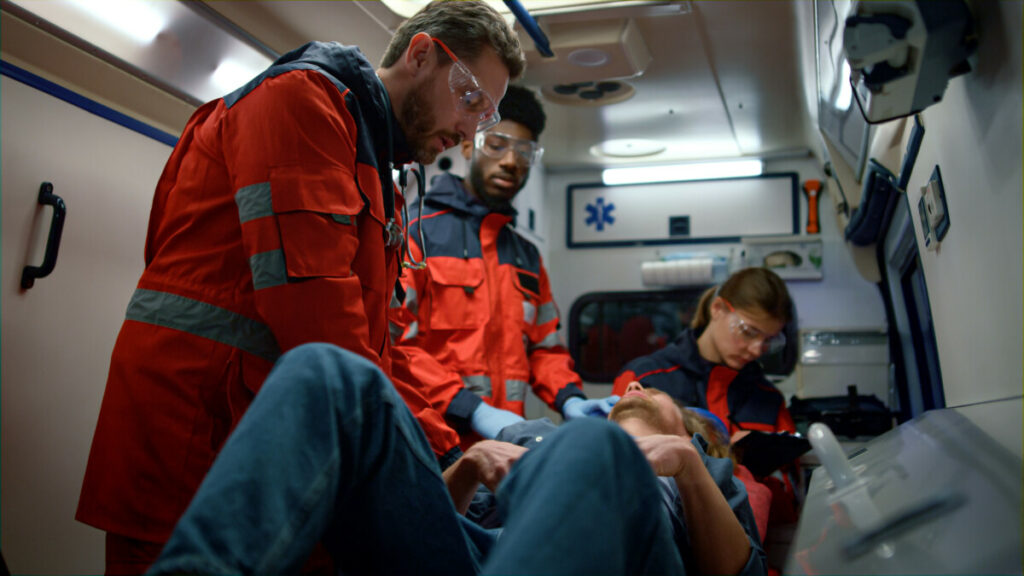This post may contain affiliate links, which means if you enroll through my link, I’ll receive a small commission at no extra cost to you.

An ambulance ride is an essential service that can be lifesaving for those in critical conditions. However, it can also come at a high cost, especially for those who don’t have insurance. So, how much does an ambulance cost without insurance?
The cost of an ambulance ride without insurance is $36.90 per mile on average. Other factors that impact cost are the level of care provided and the provider of the ambulance service. In some cases, patients may receive separate bills from the ambulance provider, the paramedics, and the hospital.
If you or a loved one ever need an ambulance ride, it’s important to be aware of the potential costs involved. Understanding the factors that can affect the price can help you prepare financially. Below, we will dive deeper into the cost of ambulance rides without insurance, discuss ways to lower the cost, and provide tips for dealing with the bills that come after the ride.
The Average Cost of an Ambulance Ride Without Insurance
An ambulance ride is often the fastest and most efficient way to get to the hospital during a medical emergency. However, the cost of an ambulance ride without insurance can be expensive, leaving many people with unexpected medical bills.
The average cost of an ambulance ride without insurance in the United States is around $450 for a ground ambulance. However, the cost can vary widely depending on several factors. For example, air ambulance rides can cost significantly more, ranging from $12,000 to $25,000, depending on the distance traveled and the level of medical care required, which we will talk more about later.
Another factor that can impact the cost of an ambulance ride is the distance traveled. Most ambulance services charge per mile, and rates can vary depending on the provider. Additionally, the level of medical care required can also impact the cost of an ambulance ride. Basic life support (BLS) ambulance rides typically cost less than advanced life support (ALS) ambulance rides, which offer more extensive medical care.
It’s important to note that in addition to the base cost of the ambulance ride, there may be additional fees, such as a fee for using oxygen or administering medication. These fees can add up quickly and should be taken into account when considering the total cost of an ambulance ride.
Factors that Affect the Cost of Ambulance Services

In addition to the fees already mentioned, there are a few other potential fees that patients and their families should keep in mind when considering the cost of an ambulance ride. While some of these fees may be less common or applicable only in certain situations, they are still important to understand in order to avoid any surprises.
One potential fee that patients may encounter is a mileage fee. This fee is typically charged based on the distance traveled during the ride and can add up quickly for patients who require transportation over long distances. In some cases, insurance policies may cover a certain number of miles or include a cap on the mileage fees that can be charged, so it’s important to check the details of the policy to see if this is the case.
Another potential fee is an additional personnel fee. If a patient requires additional medical personnel, such as a nurse or paramedic, during the ride, the ambulance company may charge an extra fee for their services. This fee may be charged on top of any other fees related to the type of ambulance or level of care required.
Patients who require an ambulance ride due to a contagious disease may also be subject to a hazmat fee. This fee covers the cost of specialized cleaning and equipment required after transporting a patient with a highly infectious disease. While this fee is relatively rare, it’s important to be aware of the potential cost in case it applies to a specific situation.
Finally, some ambulance companies may charge a cancellation fee if a patient cancels a scheduled ride. This fee can vary depending on the company and the circumstances of the cancellation, but it’s important to ask about this potential fee when scheduling a ride to avoid any unexpected charges.
As with all potential fees associated with an ambulance ride, it’s important for patients and their families to ask about these costs upfront and to carefully review any bills or invoices received from the ambulance company. By being proactive and informed about potential fees, patients can ensure that they receive the care they need without facing unexpected financial burdens.
Additional Fees to Watch Out for
In addition to the factors mentioned above, there are other factors that can affect the cost of an ambulance ride. Here are some additional factors to consider:
Level of Care Needed: The level of care needed can also impact the cost of the ride. For example, critical care transport may be necessary for patients who require specialized equipment and highly trained medical personnel before they reach the hospital.
Number of Passengers: If more than one person needs to be transported in the ambulance, the cost may be higher than if only one person needed to be treated. This is because additional staff and equipment may be required to accommodate multiple passengers.
Emergency vs. Non-Emergency: Ambulance rides can be classified as either emergency or non-emergency. Emergency rides are typically more expensive because they require immediate response and specialized equipment. Non-emergency rides, such as those that transport people to medical appointments, may be less expensive.
Medical Supplies and Equipment: In addition to the use of specialized medical equipment, such as defibrillators and oxygen, the cost of the medical supplies used during the ride can also impact the overall cost.
Billing Practices: Ambulance providers may use different billing practices that can impact the cost of the ride. For example, some providers may bill by the mile, while others may use a flat fee. It is important to understand the billing practices used by your ambulance ride provider to avoid any surprises when the bill arrives.
Ways to Lower the Cost of an Ambulance Ride without Health Insurance

Ambulance rides can be expensive, especially if you do not have insurance. However, there are ways to negotiate the cost of an ambulance ride, even if you are uninsured.
Negotiating the cost of an ambulance ride can be a daunting task, but it is worth exploring if you are uninsured or facing a high out-of-pocket cost. Many ambulance providers are open to negotiation and may be willing to work with patients to lower the cost of the ride.
To begin the negotiation process, it is best to call the ambulance company in advance and explain your situation. Be sure to have all relevant information on hand, including the nature of the emergency, the distance traveled, and any additional services provided during the ride. This will allow the ambulance company to provide you with an accurate estimate of the cost.
Once you have received an estimate, ask if there is any room for negotiation. If the initial cost seems too high, ask if there are any discounts or payment plans available. Be prepared to provide a reasonable counteroffer, based on your financial situation and the cost of similar services in your area.
If the ambulance company is willing to negotiate, be sure to get all agreements in writing, including the agreed-upon cost, any payment plans, and the timeframe for payment. Make sure to read the terms and conditions carefully and ask any questions you may have before signing the agreement.
It is also worth noting that some ambulance companies may be more willing to negotiate if you have already received the service and are facing a high bill. In this case, it may be helpful to gather documentation of your financial situation and any medical bills you have already incurred. This can help demonstrate your need for assistance and make a strong case for negotiation.
Overall, negotiating the cost of an ambulance ride can be a worthwhile effort in reducing the financial burden of emergency medical care. With a little research and preparation, patients can work with ambulance providers to find a solution that works for their individual needs and budget.
When you receive a bill for an ambulance ride, it’s important to carefully review the charges and ask for a detailed breakdown of the costs. This will help you understand exactly what you’re being charged for and identify any errors or duplicate charges that may have been included.
Once you have a detailed bill, ask the ambulance company if there are any discounts or payment plans available. Many ambulance providers offer discounts to uninsured patients or those who pay their bills in full upfront. You may also be able to negotiate a payment plan or ask about installment options if you’re unable to pay the full amount at once.
It’s important to be proactive when it comes to managing the cost of an ambulance ride, especially if you’re uninsured or facing financial hardship. By asking for a detailed bill and exploring all available payment options, you can work to reduce the financial burden of this important service and ensure that you receive the care you need without facing unexpected bills or debts.
What to Do if You Can’t Afford an Ambulance Ride
If you can’t afford an ambulance ride, there are several things you can do to get the care you need without breaking the bank.
Apply For Financial Assistance
Financial assistance programs can be a great resource for individuals who are struggling to pay for medical care, including ambulance rides. Many ambulance providers and hospitals offer such programs to help reduce the financial burden on patients who cannot afford the full cost of care.
To inquire about financial assistance programs, contact the ambulance provider or hospital billing department. They can provide you with information on the types of programs available and the eligibility criteria. Some programs may be based on income or other financial needs, while others may be based on specific medical conditions or circumstances.
It is important to keep in mind that the application process for financial assistance programs can vary depending on the provider and program. You may need to provide documentation of your income and expenses, as well as information about your medical condition and treatment. Some programs may require you to submit an application or provide additional information, while others may offer immediate discounts or payment plans.
If you are not eligible for a financial assistance program, there may still be other options available to help you cover the cost of an ambulance ride. For example, you may be able to set up a payment plan with the ambulance provider or hospital, or you may be able to negotiate a lower rate for the services you received. It is always a good idea to explore all of your options and to work with the provider to find a solution that works for you.
Consider Using Non-Emergency Transporting
In some cases, non-emergency transportation may be more affordable than an ambulance ride. For example, if you need to see a doctor for a non-life-threatening condition, you may be able to use a medical transportation service or a rideshare service to get to your appointment. These services are typically less expensive than an ambulance ride. However, don’t use non-emergency transportation or rideshare services if you are having a medical emergency, as those who work for these services are not trained to handle medical emergencies.
Some ambulance providers offer membership programs that provide discounted rates for members. These programs may require an annual fee, but they can be a good option if you anticipate needing ambulance services in the future. Check with local ambulance providers to see if they offer membership programs.
Contact Community Organizations
There may be community organizations that offer assistance for medical expenses. Contact local non-profits or religious organizations to see if they offer any financial assistance programs.
Apply for Government Assistance
In some cases, you may be eligible for government assistance to cover the cost of an ambulance ride. Contact your local health department or social services office to inquire about assistance programs.
No Insurance?
When it comes to your healthcare, most people think that their only options are to pay for expensive Health Insurance or try out your luck being uninsured.
The great news is that you have a third option; You can join a Health Share plan that is affordable and meets your needs! Health Sharing programs are one of the most effective and affordable alternatives to Health Insurance.
If you don’t know what a Health Share is, you can start here to learn how it works and why it’s a great alternative to health insurance. If you are looking for affordable healthcare, I highly recommend checking out my article about the Best Health Share Plans.
Health shares are not insurance and do not offer insurance coverage. Membership in a health share does not guarantee the payment or reimbursement of medical expenses. Each organization operates under its own membership guidelines, which determine what expenses may be eligible for sharing. This publication is for informational purposes only and is not provided by an insurance company. For state-specific notices and full program details, please visit the respective health share’s official website.





Leave a Reply